How to Add a Point of Sale Section to your Craft Show Display
Your craft show table should be treated like a mini boutique. And retailers know how important a shopper’s experience is in the checkout line or at the till.
This is the point at which a sale is made, and you should be using it to increase your units per transaction, better serve your customers, and boost your revenue.
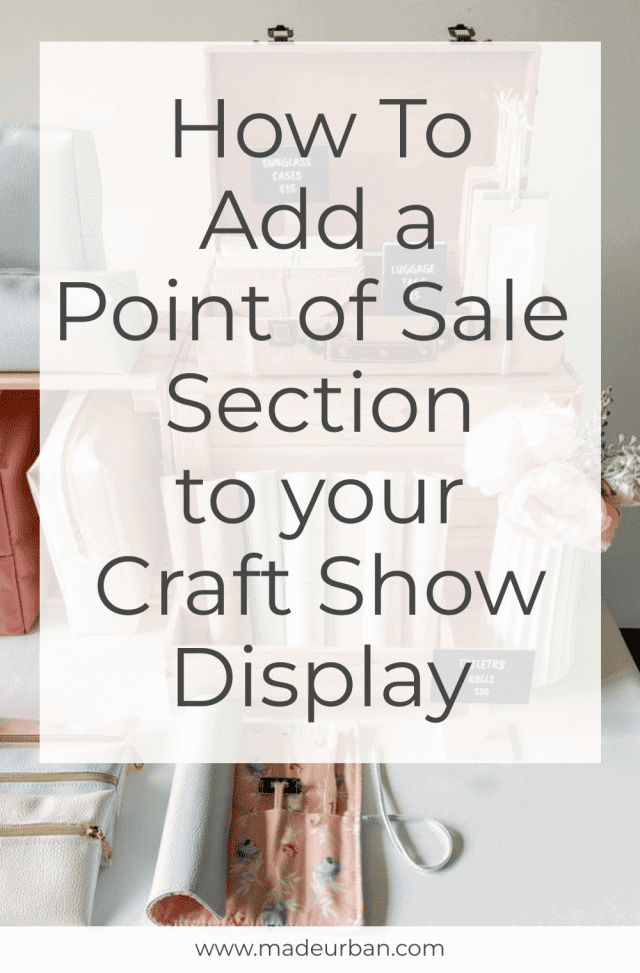
What is a point of sale display?
In the merchandising world, there are different versions of “point of sale displays”, like the displays at the end of grocery store aisles that are promoting a new product.
However, when I refer to “point of sale display”, I mean the displays you find at the checkout counter. The point where a sale is made.
>> Think of the chocolate bars and magazines displayed in the cashier line at a grocery store.
>> Or the gadgets table in front of a checkout counter at Chapters.
>> Or the shoe cleaner displayed on the checkout counter at a shoe store.
Simply put, a point of sale display (P.O.S) is a section of products in the checkout area.
Why is a point of sale display important?
As a business, the point of sale display is an opportunity for you to earn more money.
Customers can browse items in your point of sale display while they wait to pay or while you’re ringing through their purchase.
These items are easy for a customer to add to their purchase and if they do, it will increase your value per transaction and units per transaction.
But a business can’t just be about making money; you must also think about the customer.
To the customer, a point of sale display should help:
- complete a purchase (e.g. a wallet to go with their new purse)
- care for their purchase (e.g. leather spray to protect their new purse)
- or upgrade a purchase (e.g. adding a gift box or gift wrapping)
Items displayed in a point of sale section should help customers walk away feeling satisfied and impressed with your business.
Where to put a point of sale section at a craft show
Your point of sale display should go in your checkout area.
Even if you don’t have a lot of space at a craft show, you can still create a checkout section on your table (as shown in the photo below).
The checkout area should go at the end of your table or booth, keeping the flow of traffic in mind. Meaning, if most shoppers will be approaching from the left, the checkout should on the right end of your table or right side of your booth.
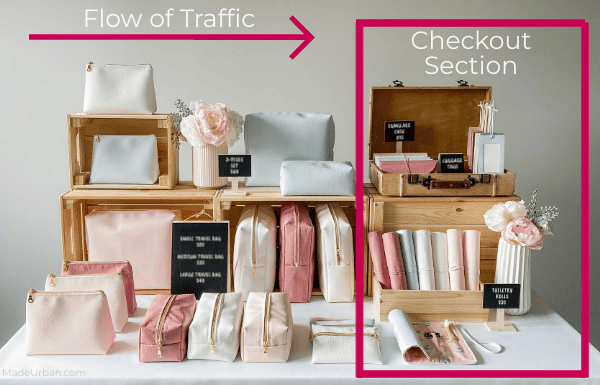
If there isn’t a clear flow of traffic and shoppers come from all directions, to signal to shoppers where your checkout area is you might use:
- signage – on a craft show table you might use a small sign that indicates payment forms you accept. In a larger booth you might hang a sign above your checkout area (e.g. Pay Here).
- space – leaving a blank space on your table can subtly indicate that it’s a spot for shoppers to set down their purse/wallet or items to pay.
- props – if you have the space, you may display a couple shopping bags stuffed with tissue to not only show shoppers how nicely you package purchases, but also to indicate where the checkout is.
What to put in your point of sale section
There are 3 keys I like to keep in mind when considering products for a point of sale (P.O.S) display.
1 – Price
Items in this section should be lower than your average price point.
If a shopper has hemmed and hawed over an item and is now ready to pay, they’re unlikely to add a higher priced item to their purchase last minute.
The appropriate price range for your point of sale items will depend on the price points of the “main” products you sell.
For example, if an artist mainly sells original paintings valued over $1000, a $100 add-on would be appropriate (e.g. an oil painting cleaning kit).
On the other hand, a vendor with a table full of $20 hair accessories would want to keep their point of sale items around the $10 and under mark.
If a shopper has a $20 item in their hand, it will be a shock to see $50 items in the checkout area.
They only have a few minutes to look over products in your point of sale section. And the higher the price point, the more time is required to consider the purchase.
These items should be a no-brainer to buy and require very little time to think about.
2 – Size
The items displayed in your checkout area must fit in your checkout area.
Shoppers shouldn’t need to step away from the checkout to view P.O.S items, so the smaller the better.
If you have a booth at a craft show, you might be able to set a shelf or fixture next to your checkout table.
But if you have a table, your items must fit in front of where you stand to process transactions.
3 – Connection
The items in your point of sale section should have a clear connection to the items in the rest of your display.
If shoppers can’t connect the dots from the item in their hands to the ones in your point of sale display, they’ll be less likely to buy.
For example, if I’m selling travel bags on my craft show table, mittens, potholders, or hand warmers don’t make sense in my point of sale section.
On the other hand, if someone is waiting to buy a travel case, a toiletry roll or sunglass case that fits in that travel case makes sense for them to add to their purchase.
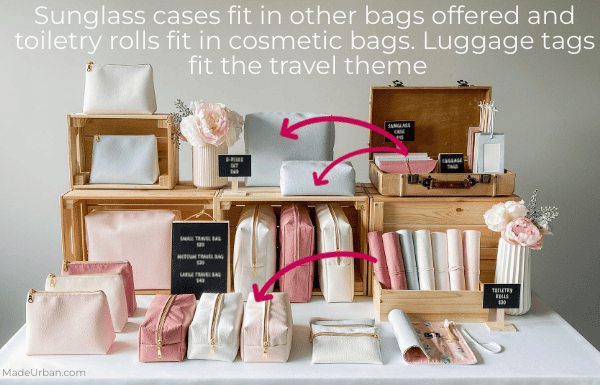
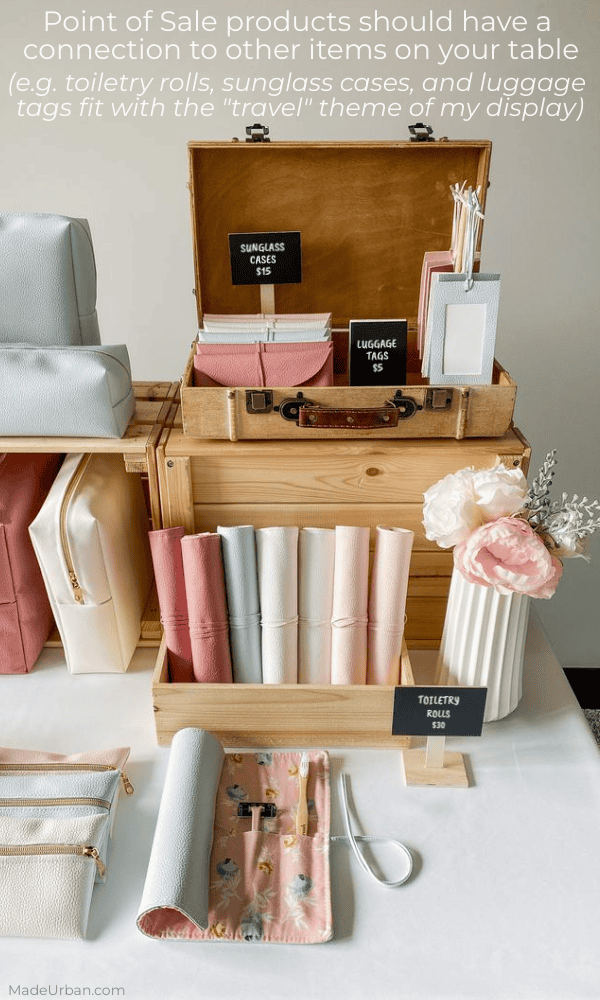
Additional tips for your point of sale display
Keep these other points in mind when planning your point of sale section.
Quantity
Don’t overwhelm shoppers with choices.
They’ve already depleted their decision making battery by deciding on the item they’re waiting to pay for. They need these final decisions to be simple.
1 – 5 items will be plenty for your point of sale section.
Lots of selection is appealing to shoppers at first glance, but the more options there are, the fewer people will buy (Sheena Iyengar has conducted studies on this…I’ve covered one of her studies in this article).
Signage
Because shoppers will likely have their hands full (with their purchase or their money), or they may be standing in line to pay and unable to touch your point of sale items just yet, use clear signage to communicate prices.
This way, shoppers don’t have to pick up an item to see the price; they can see prices at a glance or from a few feet away.
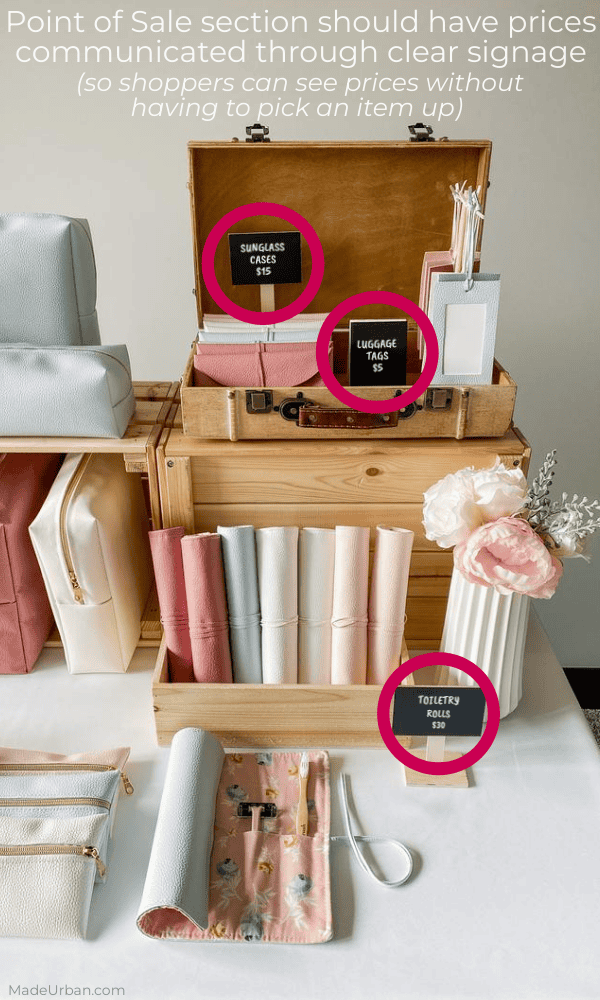
Space
If you can, it’s nice to have a blank spot in your point of sale section that allows a shopper to set down their purse, wallet, or the item they’re buying.
This not only makes it easier for them to browse your point of sale items, but easier to pay too.
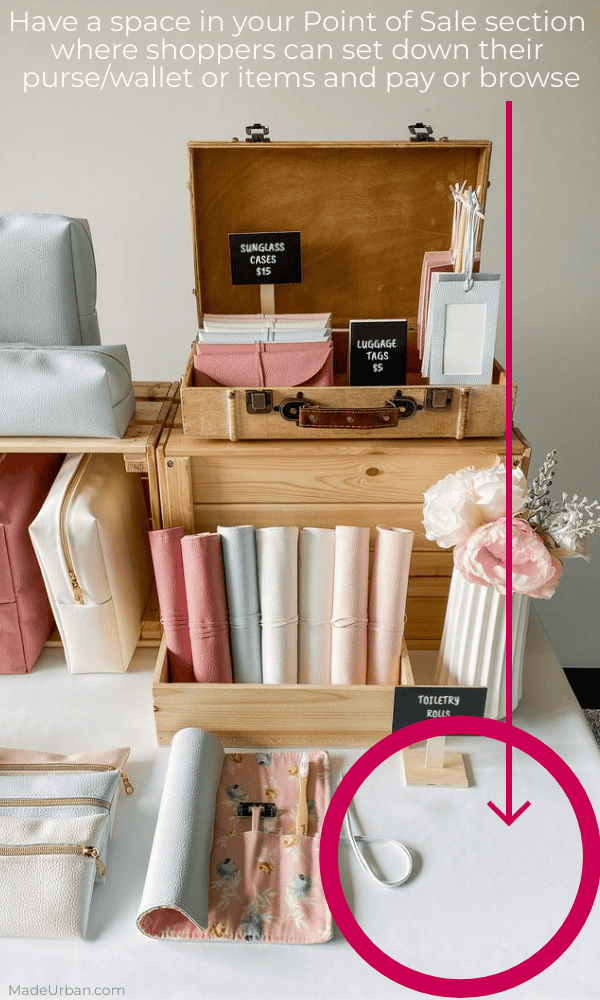
Non-physical items
Not everything can be displayed in a point of sale display.
There may be a service you offer, which can be communicated through signage in your P.O.S section, or as a sales pitch as you complete the shopper’s transaction.
For example, an artist selling original paintings may offer a delivery and hanging service for their art. They may have a sign at their checkout area advertising this service and cost, or they may tell the customer about it as they’re writing up an invoice.
You can also keep point of sale items behind your table/checkout area.
For example, you may sell gift boxes and bags. You don’t need to display all the bags and boxes you offer. But rather, ask each customer if they would like to add a gift bag/box to their order.
You could have a small display that shows what their purchase will look like packaged in a gift box and wrapped with a bow. Or, as you ask them, you may hold up a gift box you keep behind your table.
Brand
Keep this section on-brand. It’s going to be the last interaction they have with your business (at that event), so you want it to be a good one.
Although you can place sale items in this section, don’t “junk it up” with shop-worn, out-of-date, out-of-style products that are leftovers from last year’s craft shows.
Keep the products and experience on-brand.
And if you’re reading this article before the holidays, your point of sale section is the perfect place for stocking stuffers. Here are dozens of stocking stuffer items you can make and sell.
Other craft show display sections
A point of sale section is just one section of your display. Creating zones within your display is an easy way to break it up and make it easier for people to shop.
For more details on how to create zones in your display, check out:
>> Craft Show Table Layout Tips
I hope this article helps you improve your display with a point of sale section! Let me know in the comments if you have any questions 🙂

Hey, I’m Erin 🙂 I write about small business and craft show techniques I’ve learned from being a small business owner for almost 2 decades, selling at dozens of craft shows, and earning a diploma in Visual Communication Design. I hope you find my advice helpful!

Hi! Where are your little signs from? I LOVE them!
Hi Beckie!
I purchased the chalkboard easel and “4.7 stand” from Michaels. You’ll find some options here: https://www.michaels.com/shop/crafts-hobbies/wood-blank-crafting-surfaces/chalkboard-surfaces
I also created a little easel out of foam core and then painted it with chalkboard paint. That’s the more economic version 🙂
~Erin
Thank you!
Hi Erin,
I’ve been reading your blogs for a good while now. Absolutely love your tips and advice.
My question is that I have completed my first year doing fairs, what do I do with the stock not sold? Tried sales, end of season offers??
Thank you
AD
Hi AD,
I’m so happy to hear you’ve been enjoying my advice 🙂
If you’ve tried marking the stock down and it’s still not selling, if it’s seasonal, it may be best to just hang onto it for next year’s craft shows. For example, summery prints may not sell during the winter, even if they are marked down. But if you display them at next year’s spring craft shows, they may sell without marking them down.
You may also consider working with local retailers as they’ll reach a different audience than you. They’ll take a commission/require wholesale pricing but it may be worth it to get the stock sold.
Although this article was written during the pandemic and regarding craft shows canceled because of the pandemic, you may find some other ideas in it: https://www.madeurban.com/blog/how-to-sell-stock-from-canceled-craft-shows/
I hope that helps!
~Erin